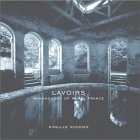-
History of:
- Resources about:
- More:
- Baby walkers
- Bakehouses
- Bed warmers
- Beer, ale mullers
- Besoms, broom-making
- Box, cabinet, and press beds
- Butter crocks, coolers
- Candle snuffers, tallow
- Clothes horses, airers
- Cooking on a peat fire
- Drying grounds
- Enamel cookware
- Fireplaces
- Irons for frills & ruffles
- Knitting sheaths, belts
- Laundry starch
- Log cabin beds
- Lye and chamber-lye
- Mangles
- Marseilles quilts
- Medieval beds
- Rag rugs
- Rushlights, dips & nips
- Straw mattresses
- Sugar cutters - nips & tongs
- Tablecloths
- Tinderboxes
- Washing bats and beetles
- Washing dollies
- List of all articles
Subscribe to RSS feed or get email updates.
Lavoirs: Washhouses of Rural France from Amazon.com
Another peculiarity is the washerwomen's ark [box], which you may see at every village: a little wooden raft, with a bench upon the side next the stream, on which the sturdy washerwomen work their clothes after dipping them in the river.
John Price Durbin, Observations in Europe: Principally in France and Great Britain, 1844
Washboards at the riverside
Board, box, and bench in France and southern Europe >> also Wash-houses
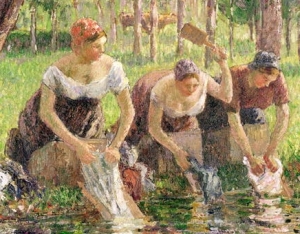 Washerwomen
at the riverside were a common subject for 19th century French artists. Some of
their work shows not only the French version of a washboard, but the three-sided
box or caisse that went with it. The woman knelt in the box and her skirt
stayed dry. For more comfort, she could pad it
with straw to cushion her knees.
Washerwomen
at the riverside were a common subject for 19th century French artists. Some of
their work shows not only the French version of a washboard, but the three-sided
box or caisse that went with it. The woman knelt in the box and her skirt
stayed dry. For more comfort, she could pad it
with straw to cushion her knees.
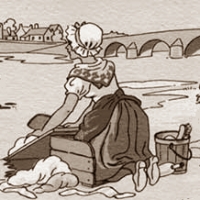 When Americans think of their great-grandmothers
using a traditional washboard, or British people recall old
washing dollies, French memories are more likely to be of a box and board.
(These were also known in
Spain.) In France living history events or re-creations of traditional ways
of life may feature women in 19th century costume using the box and board, in the
many regions where this was common.
When Americans think of their great-grandmothers
using a traditional washboard, or British people recall old
washing dollies, French memories are more likely to be of a box and board.
(These were also known in
Spain.) In France living history events or re-creations of traditional ways
of life may feature women in 19th century costume using the box and board, in the
many regions where this was common.
The riverside washerwomen had sometimes soaked their laundry in lye before taking it to the water's edge, as described in Zola's Dream, quoted on the page about the "great wash". The rather snooty-sounding English travel writers (see left-hand column) offer a picture of the women and their equipment but no real information on washing techniques.
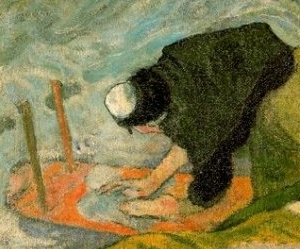 In some areas benches with legs were more popular than a plain board. They could
be used upside down as in the Gauguin painting (right) - or looking more
like ironing boards, low or high, at the edge of the water. Sometimes the
women got into tubs or barrels rather than boxes.
In some areas benches with legs were more popular than a plain board. They could
be used upside down as in the Gauguin painting (right) - or looking more
like ironing boards, low or high, at the edge of the water. Sometimes the
women got into tubs or barrels rather than boxes.
 This website has another article discussing the origins
of washboards, saying how hard it is to find evidence of ridged washboards
in use before the 19th century, except in Scandinavia. Smooth boards can be seen
in earlier pictures of Italian washerwomen. The
boards and benches on this page are all 19th century. The
washing bat or battoir in the first two pictures was a very familiar
traditional tool, used with or without other equipment.
This website has another article discussing the origins
of washboards, saying how hard it is to find evidence of ridged washboards
in use before the 19th century, except in Scandinavia. Smooth boards can be seen
in earlier pictures of Italian washerwomen. The
boards and benches on this page are all 19th century. The
washing bat or battoir in the first two pictures was a very familiar
traditional tool, used with or without other equipment.
Wash-houses
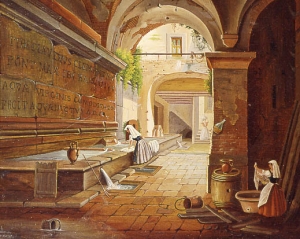 Women could work together by the river,
or in the other communal laundry places: the public wash-houses. These were usually
open-air, though often roofed, in France (lavoirs) and southern Europe.
Some were based on a simple village fountain spilling over into a basin, while others
were large purpose-built facilities. In some regions there was a special version,
a laundry-boat moored
on the riverbank, a bateau-lavoir, giving easy access to river-water.
Women could work together by the river,
or in the other communal laundry places: the public wash-houses. These were usually
open-air, though often roofed, in France (lavoirs) and southern Europe.
Some were based on a simple village fountain spilling over into a basin, while others
were large purpose-built facilities. In some regions there was a special version,
a laundry-boat moored
on the riverbank, a bateau-lavoir, giving easy access to river-water.
The Italian wash-house illustrated (right) also has a barrel and tub for soaking in water and ashes (lye). Note the plug-holes to let the liquid run out for re-heating as described on this page about lye.
At one of the public fountains I counted fifteen washerwomen in a row, with benches upon which they rub the clothes, and pound them with wooden bats.
[Travelling through Le Havre, France, in 1829], Rembrandt Peale, Notes on Italy, 1831
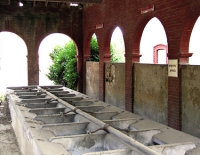 Some wash-houses were built with
sloping sides to the water-basin. Even when
they were flat, the surrounds could be used exactly like any washboard,
as a surface for rubbing or brushing soap into soiled cloth. There are still lots
of open-air wash-houses to be seen in the warmer parts of Europe, but they are rarely
used.
Some wash-houses were built with
sloping sides to the water-basin. Even when
they were flat, the surrounds could be used exactly like any washboard,
as a surface for rubbing or brushing soap into soiled cloth. There are still lots
of open-air wash-houses to be seen in the warmer parts of Europe, but they are rarely
used.
The wash-house tradition is still alive in other countries including Guatemala, illustrated below.
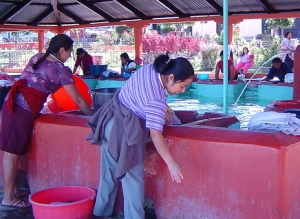 See
more French washing
pictures, and more
laundry boats.
See
more French washing
pictures, and more
laundry boats.
...when we got into the country [near Bordeaux], I was amused by seeing the French mode of washing their clothes; eight or ten washerwomen were collected by the side of a stream of water, each furnished with a large tub and a small bench or stool; instead of putting her clothes into the tub, each woman, after fixing it in the stream, got into it herself, and with her stool attached to the side of it by two legs, she was first sousing her clothes into the stream, and then beating and rubbing them upon the stool with an instrument in her hand something like a small bat.
Jane E Roscoe, Memoir of the Reverend Benjamin Goodier, 1825
 23 January 2008
23 January 2008
You may like our new sister site Home Things Past where you'll find articles about antiques, vintage kitchen stuff, crafts, and other things to do with home life in the past. There's space for comments and discussion too. Please do take a look and add your thoughts. (Comments don't appear instantly.)
For sources please refer to the books page, and/or the excerpts quoted on the pages of this website, and note that many links lead to museum sites. Feel free to ask if you're looking for a specific reference - feedback is always welcome anyway. Unfortunately, it's not possible to help you with queries about prices or valuation.


